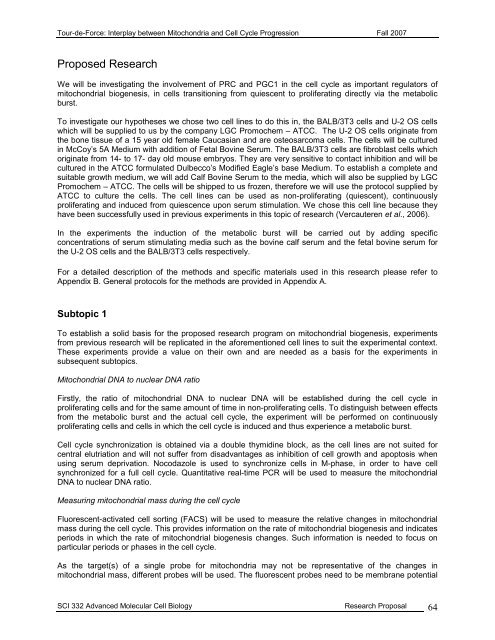Tour-de-Force
Tour-de-Force
Tour-de-Force
Create successful ePaper yourself
Turn your PDF publications into a flip-book with our unique Google optimized e-Paper software.
<strong>Tour</strong>-<strong>de</strong>-<strong>Force</strong>: Interplay between Mitochondria and Cell Cycle Progression Fall 2007Proposed ResearchWe will be investigating the involvement of PRC and PGC1 in the cell cycle as important regulators ofmitochondrial biogenesis, in cells transitioning from quiescent to proliferating directly via the metabolicburst.To investigate our hypotheses we chose two cell lines to do this in, the BALB/3T3 cells and U-2 OS cellswhich will be supplied to us by the company LGC Promochem – ATCC. The U-2 OS cells originate fromthe bone tissue of a 15 year old female Caucasian and are osteosarcoma cells. The cells will be culturedin McCoy’s 5A Medium with addition of Fetal Bovine Serum. The BALB/3T3 cells are fibroblast cells whichoriginate from 14- to 17- day old mouse embryos. They are very sensitive to contact inhibition and will becultured in the ATCC formulated Dulbecco’s Modified Eagle’s base Medium. To establish a complete andsuitable growth medium, we will add Calf Bovine Serum to the media, which will also be supplied by LGCPromochem – ATCC. The cells will be shipped to us frozen, therefore we will use the protocol supplied byATCC to culture the cells. The cell lines can be used as non-proliferating (quiescent), continuouslyproliferating and induced from quiescence upon serum stimulation. We chose this cell line because theyhave been successfully used in previous experiments in this topic of research (Vercauteren et al., 2006).In the experiments the induction of the metabolic burst will be carried out by adding specificconcentrations of serum stimulating media such as the bovine calf serum and the fetal bovine serum forthe U-2 OS cells and the BALB/3T3 cells respectively.For a <strong>de</strong>tailed <strong>de</strong>scription of the methods and specific materials used in this research please refer toAppendix B. General protocols for the methods are provi<strong>de</strong>d in Appendix A.Subtopic 1To establish a solid basis for the proposed research program on mitochondrial biogenesis, experimentsfrom previous research will be replicated in the aforementioned cell lines to suit the experimental context.These experiments provi<strong>de</strong> a value on their own and are nee<strong>de</strong>d as a basis for the experiments insubsequent subtopics.Mitochondrial DNA to nuclear DNA ratioFirstly, the ratio of mitochondrial DNA to nuclear DNA will be established during the cell cycle inproliferating cells and for the same amount of time in non-proliferating cells. To distinguish between effectsfrom the metabolic burst and the actual cell cycle, the experiment will be performed on continuouslyproliferating cells and cells in which the cell cycle is induced and thus experience a metabolic burst.Cell cycle synchronization is obtained via a double thymidine block, as the cell lines are not suited forcentral elutriation and will not suffer from disadvantages as inhibition of cell growth and apoptosis whenusing serum <strong>de</strong>privation. Nocodazole is used to synchronize cells in M-phase, in or<strong>de</strong>r to have cellsynchronized for a full cell cycle. Quantitative real-time PCR will be used to measure the mitochondrialDNA to nuclear DNA ratio.Measuring mitochondrial mass during the cell cycleFluorescent-activated cell sorting (FACS) will be used to measure the relative changes in mitochondrialmass during the cell cycle. This provi<strong>de</strong>s information on the rate of mitochondrial biogenesis and indicatesperiods in which the rate of mitochondrial biogenesis changes. Such information is nee<strong>de</strong>d to focus onparticular periods or phases in the cell cycle.As the target(s) of a single probe for mitochondria may not be representative of the changes inmitochondrial mass, different probes will be used. The fluorescent probes need to be membrane potentialSCI 332 Advanced Molecular Cell Biology Research Proposal 64
















